Effect of Tillage Systems on the Yield and Quality of Winter Wheat Grain and Soil Properties
Abstract
:1. Introduction
2. Materials and Methods
2.1. Experiment Localization and Scheme
2.2. Soil and Weather Conditions
2.3. Production Traits and Statistical Analysis
3. Results
3.1. Grain Yield and Its Components
3.2. Grain Quality Attributes
3.3. Soil Properties
4. Discussion
5. Conclusions
Author Contributions
Funding
Conflicts of Interest
References
- Rachoń, L.; Szumiło, G.; Brodowska, M.; Woźniak, A. Nutritional value and mineral composition of grain of selected wheat species depending on the intensity of a production technology. J. Elem. 2015, 20, 705–715. [Google Scholar]
- Rial-Lovera, K.; Davies, W.P.; Cannon, N.D.; Conway, J.S. Influence of tillage systems and nitrogen management on grain yield, grain protein and nitrogen-use efficiency in UK spring wheat. J. Agric. Sci. 2016, 154, 1437–1452. [Google Scholar] [CrossRef]
- Guzmán, C.; Autrique, E.; Mondal, S.; Huerta-Espino, J.; Singh, R.P.; Vargas, M.; Crossa, J.; Amaya, A.; Pena, R.J. Genetic improvement of grain quality traits for CIMMYT semi-dwarf spring bread wheat varieties developed during 1965–2015: 50 years of breeding. Field Crops Res. 2017, 210, 192–196. [Google Scholar] [CrossRef]
- Skudra, I.; Ruza, A. Winter wheat grain baking quality depending on environmental conditions and fertilizer. Agron. Res. 2016, 14, 1460–1466. [Google Scholar]
- Rachoń, L.; Woźniak, A. Variability of spring durum and common wheat yields in the decade 2009–2018 in the Lublin region. Agron. Sci. 2020, 75, 67–74. [Google Scholar] [CrossRef]
- Kunzová, E. The effect of crop rotation and fertilization on dry matter yields and organic C content in soil in long-term field experiments in Prague. Arch. Agron. Soil Sci. 2013, 59, 1177–1191. [Google Scholar] [CrossRef]
- Hernanz, J.L.; Sánchez-Girón, V.; Navarrete, L.; Sánchez, M.J. Long-term (1983–2012) assessment of three tillage systems on the energy use efficiency, crop production and seeding emergence in a rain fed cereal monoculture in semiarid conditions in central Spain. Field Crops Res. 2014, 166, 26–37. [Google Scholar] [CrossRef]
- Plaza-Bonilla, D.; Nolot, J.M.; Raffaillac, D.; Justes, E. Innovative cropping systems to reduce N inputs and maintain wheat yields by inserting grain legumes and cover crops in southwestern France. Eur. J. Agron. 2017, 82, 331–341. [Google Scholar] [CrossRef] [Green Version]
- Woźniak, A.; Soroka, M. Effect of crop rotation and tillage system on the weed infestation and yield of spring wheat and on soil properties. Appl. Ecol. Environ. Res. 2018, 16, 3087–3096. [Google Scholar] [CrossRef]
- Jensen, E.S.; Peoples, M.B.; Hauggaard-Nielsen, H. Faba bean in cropping systems. Field Crops Res. 2010, 115, 203–216. [Google Scholar] [CrossRef] [Green Version]
- Ali, S.A.; Tedone, L.; Verdini, L.; Cazzato, E.; De Mastro, G. Wheat response to no-tillage and nitrogen fertilization in a long-term faba bean-based rotation. Agronomy 2019, 9, 50. [Google Scholar] [CrossRef] [Green Version]
- Pagnani, G.; Galieni, A.; D’Egidio, S.; Visioli, G.; Stagnari, F.; Pisante, M. Effect of soil tillage and crop sequence on grain yield and quality of durum wheat in Mediterranean Areas. Agronomy 2019, 9, 488. [Google Scholar] [CrossRef] [Green Version]
- Shahzad, M.; Farooq, M.; Jabran, K.; Hussain, M. Impact of different crop rotations and tillage systems on weed infestation and productivity of bread wheat. Crop Prot. 2016, 89, 161–169. [Google Scholar] [CrossRef]
- Hernández Plaza, E.H.; Kozak, M.; Navarrete, L.; González-Andújar, J.L. Tillage system did not affect weed diversity in a 23-year experiment in Mediterranean dryland. Agricult. Ecosyst. Environ. 2011, 140, 102–105. [Google Scholar] [CrossRef]
- Woźniak, A. Effect of tillage system on the structure of weed infestation of winter wheat. Span. J. Agric. Res. 2018, 16, e1009. [Google Scholar] [CrossRef]
- Feledyn-Szewczyk, B.; Smagacz, J.; Kwiatkowski, C.K.; Harasim, E.; Woźniak, A. Weed Flora and Soil Seed Bank Composition as affected by tillage system in three-year crop rotation. Agriculture 2020, 10, 186. [Google Scholar] [CrossRef]
- Hernandez-Restrepo, M.; Groenewald, J.Z.; Elliott, M.L.; Canning, G.; McMillan, V.E.; Crous, P.W. Take-all or nothing. Stud. Mycol. 2016, 83, 19–48. [Google Scholar] [CrossRef] [Green Version]
- De Vita, P.; Di Paolo, E.; Fecondo, G.; Di Fonzo, N.; Pisante, M. No-tillage and conventional tillage effects on durum wheat yield, grain quality, and soil moisture content in Southern Italy. Soil Tillage Res. 2007, 92, 69–78. [Google Scholar] [CrossRef]
- Morris, N.L.; Miller, P.C.H.; Orson, J.H.; Froud-Williams, R.J. The adoption of non-inversion tillage systems in the United Kingdom and the agronomic impact on soil, crops and the environment—A review. Soil Tillage Res. 2010, 108, 1–15. [Google Scholar] [CrossRef]
- Gomez-Becerra, H.F.; Erdem, H.; Yazici, A.; Tutus, Y.; Torun, B.; Ozturk, L.; Cakmak, I. Grain concentrations of protein and mineral nutrients in a large collection of spelt wheat grown under different environments. J. Cereal Sci. 2010, 52, 342–349. [Google Scholar] [CrossRef]
- Woźniak, A.; Gos, M. Yield and chemical quality of spring wheat and soil properties as affected by tillage system. Plant Soil Environ. 2014, 60, 141–145. [Google Scholar] [CrossRef] [Green Version]
- Giannitsopoulos, M.L.; Burgess, P.J.; Rickson, R.J. Effects of conservation tillage systems on soil physical changes and crop yields in a wheat-oilseed rape rotation. J. Soil Water Conserv. 2019, 74, 247–258. [Google Scholar] [CrossRef]
- Woźniak, A. Chemical properties and enzyme activity of soil as affected by tillage system and previous crop. Agriculture 2019, 9, 262. [Google Scholar] [CrossRef] [Green Version]
- Lahmar, R. Adoption of conservation agriculture in Europe lesson of the KASSA project. Land Use Policy 2010, 27, 4–10. [Google Scholar] [CrossRef]
- Aziz, I.; Mahmood, T.; Islam, K.R. Effect of long-term no-till and conventional tillage practices on soil quality. Soil Tillage Res. 2013, 131, 28–35. [Google Scholar] [CrossRef]
- Ruisi, P.; Giambalvo, D.; Saia, S.; Di Miceli, G.; Frenda, A.S.; Plaia, A.; Amato, G. Conservation tillage in a semiarid Mediterranean environment: Results of 20 years of research. Ital. J. Agron. 2014, 9, 560. [Google Scholar] [CrossRef] [Green Version]
- Tebrügge, F.; Düring, R.A. Reducing tillage intensity—A review of results from long-term study in Germany. Soil Tillage Res. 1999, 53, 15–28. [Google Scholar] [CrossRef]
- Woźniak, A.; Stępniowska, A. Yield and quality of durum wheat grain in different tillage systems. J. Elem. 2017, 22, 817–829. [Google Scholar] [CrossRef]
- Morris, C.F.; Li, S.; King, G.E.; Engle, D.A.; Burns, J.W.; Ross, A.S. A comprehensive genotype and environment assessment of wheat grain ash content in Oregon and Washington: Analysis of variation. Cereal Chem. 2009, 86, 307–312. [Google Scholar] [CrossRef]
- Jug, I.; Jug, D.; Sabo, M.; Stipeševic, B.; Stošic, M. Winter wheat and yield components as affected by soil tillage systems. Turk. J. Agric. For. 2011, 35, 1–7. [Google Scholar]
- Amato, G.; Ruisi, P.; Frenda, A.S.; Di Miceli, G.; Saia, S.; Plaia, A.; Giambalvo, D. Long-term tillage and crop sequence effects on wheat grain yield and quality. Agron. J. 2013, 105, 1317–1327. [Google Scholar] [CrossRef]
- Rühlemann, L.; Schmidtke, K. Evaluation of monocropped and intercropped grain legumes for cover cropping in no-tillage and reduced tillage organic agriculture. Eur. J. Agron. 2015, 65, 83–94. [Google Scholar] [CrossRef]
- Franzluebbers, A.J.; Stuedemann, J.A. Crop and cattle production responses to tillage and cover crop management in an integrated crop-livestock system in the southeastern USA. Eur. J. Agron. 2014, 57, 62–70. [Google Scholar] [CrossRef]
- Zhang, S.; Wang, L.C.; Shi, C.; Chen, J.; Zhou, Q.; Xiong, Y. Soil respiration in a triple intercropping system under conservation tillage. Plant Soil Environ. 2015, 61, 378–384. [Google Scholar] [CrossRef] [Green Version]
- BBCH Working Group. Growth Stages of Mono-and Dicotyledonous Plants, 2nd ed.; Meier, U., Ed.; Federal Biological Research Centre for Agriculture and Forestry: Bonn, Germany, 2001; Available online: https://www.politicheagricole.it/flex/AppData/WebLive/Agrometeo/MIEPFY800/BBCHengl2001.pdf (accessed on 2 July 2010).
- IUSS Working Group. World Reference Base for Soil Resources 2014, Update 2015. International Soil Classification System for Naming Soils and Creating Legends for Soil Maps; World Soil Resources Reports No. 106; FAO: Rome, Italy, 2015; p. 192. [Google Scholar]
- Gliesmann, S.R. Agroecosystem Sustainability: Developing Practical Strategies; CRC Press: Boca Raton, FL, USA, 2001. [Google Scholar]
- Lal, R. The plow and agricultural sustainability. J. Sustain. Agric. 2009, 33, 66–84. [Google Scholar] [CrossRef]
- Soane, B.D.; Ball, B.C.; Arvidsson, J.; Basch, G.; Moreno, F.; Roger Estrade, J. No-till in northern, western and south-western Europe: A review of problems and opportunities for crop production and the environment. Soil Tillage Res. 2012, 118, 66–87. [Google Scholar] [CrossRef] [Green Version]
- Haliniarz, M.; Nowak, A.; Woźniak, A.; Sekutowski, T.R.; Kwiatkowski, C.A. Production and economic effects of environmentally friendly spring wheat production technology. Pol. J. Environ. Stud. 2018, 27, 1523–1532. [Google Scholar] [CrossRef]
- Ernst, G.; Emmerling, C. Impact of five different tillage systems on soil organic carbon content and the density, biomass, and community composition of earthworms after a ten-year period. Eur. J. Soil Biol. 2009, 45, 247–251. [Google Scholar] [CrossRef]
- Zikeli, S.; Gruber, S.; Teufel, C.F.; Hartung, K.; Claupein, W. Effects of reduced tillage on crop yield, plant available nutrients and soil organic matter in a 12-year long-term trial under organic management. Sustainability 2013, 5, 3876–3894. [Google Scholar] [CrossRef] [Green Version]
- Dimassi, B.; Mary, B.; Wylleman, R.; Labreuche, J.; Couture, D.; Piraux, F.; Cohan, J.P. Long-term effect of contrasted tillage and crop management on soil carbon dynamics during 41 years. Agric. Ecosyst. Environ. 2014, 188, 134–146. [Google Scholar] [CrossRef]
- Montemurro, F.; Maiorana, M. Cropping systems, tillage and fertilization strategies for durum wheat performance and soil properties. Int. J. Plant Prod. 2014, 8, 51–76. [Google Scholar]
- Farooq, M.; Flower, K.C.; Jabran, K.; Wahid, A.; Siddique, K.H.M. Crop yield and weed management in rainfed conservation agriculture. Soil Tillage Res. 2011, 117, 172–183. [Google Scholar] [CrossRef]
- Känkänen, H.; Alakukku, L.; Salo, Y.; Pitkänen, T. Growth and yield of different spring cereal species in zero tillage, compared to conventional tillage. Eur. J. Agron. 2011, 34, 35–45. [Google Scholar] [CrossRef]
- Woźniak, A. Mechanical and chemical weeding effects on the weed structure in durum wheat. Ital. J. Agron. 2020, 15, 1559. [Google Scholar]
- Owen, M.D.K.; Zelaya, I.A. Herbicide-resistant crops and weed resistance to herbicides. Pest Manag. Sci. 2005, 61, 301–311. [Google Scholar] [CrossRef]
- Collavo, A.; Sattin, M. First glyphosate-resistant Lolium spp. biotypes found in a European annual arable cropping system also affected by ACCase and ALS resistance. Weed Res. 2014, 54, 325–334. [Google Scholar] [CrossRef]
- Heap, I. Global perspective of herbicide-resistant weeds. Pest Manag. Sci. 2014, 70, 1306–1315. [Google Scholar] [CrossRef]
- Woźniak, A. Effect of various systems of tillage on winter barley yield, weed infestation and soil properties. Appl. Ecol. Environ. Res. 2020, 18, 3483–3496. [Google Scholar] [CrossRef]
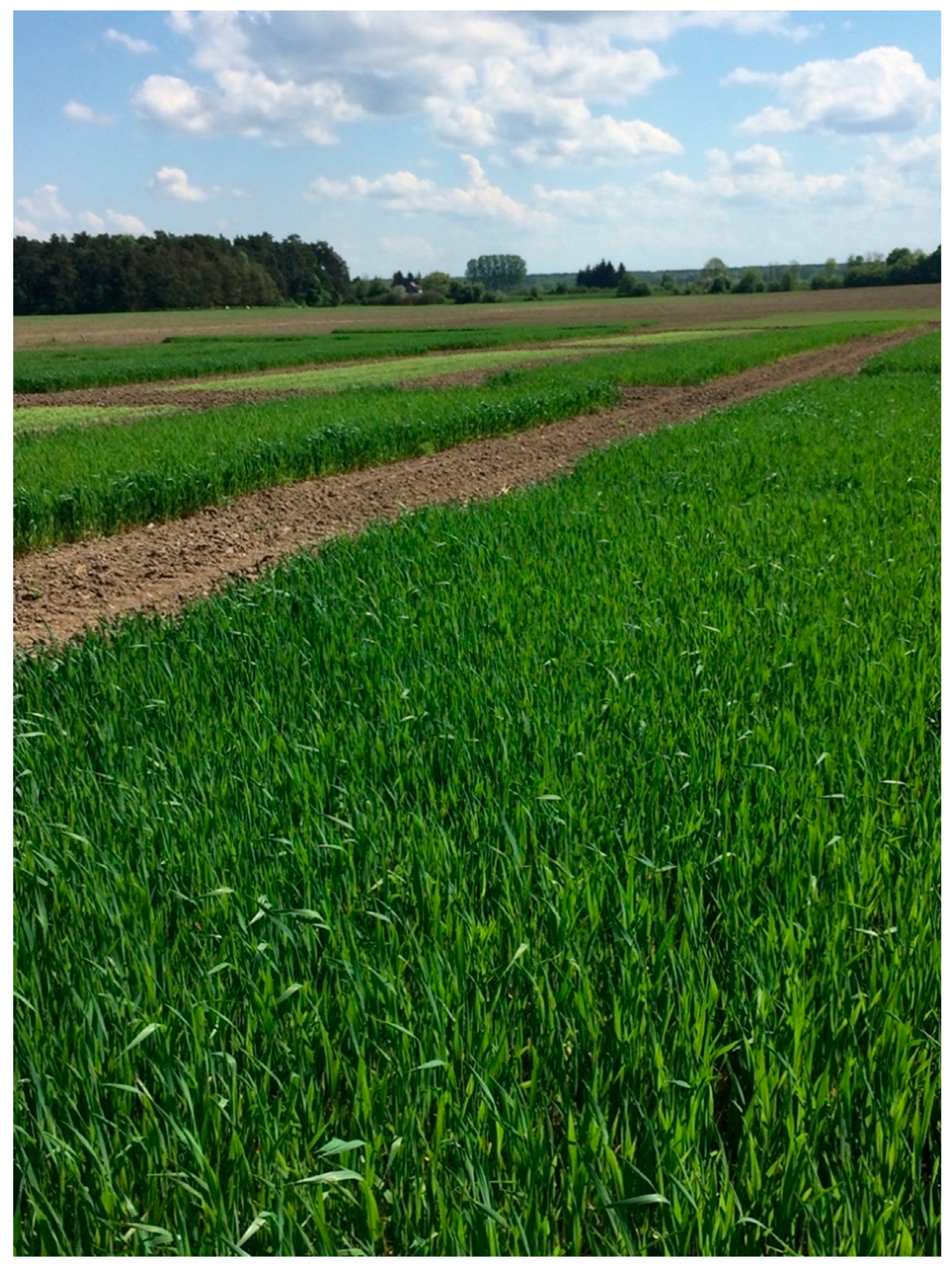
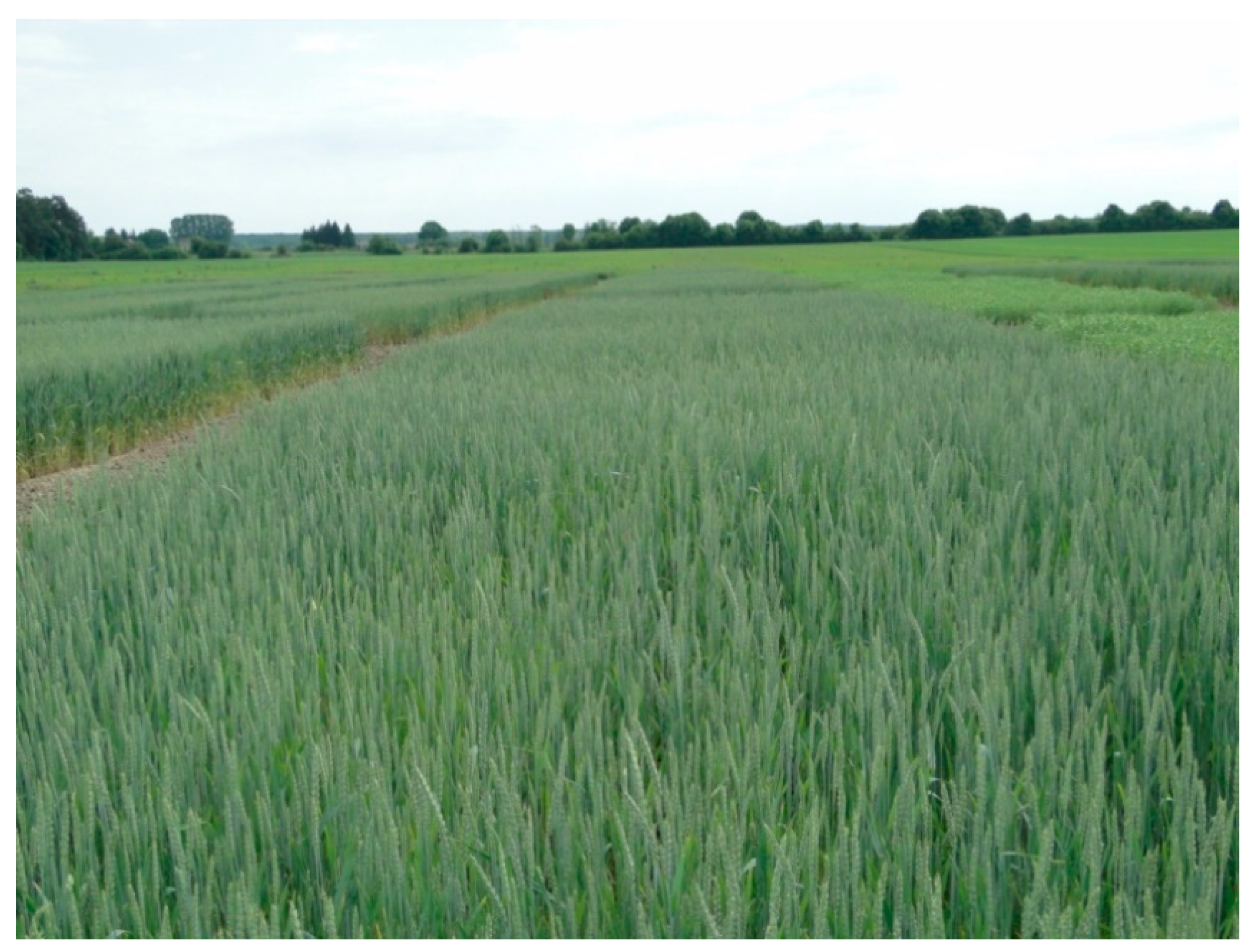

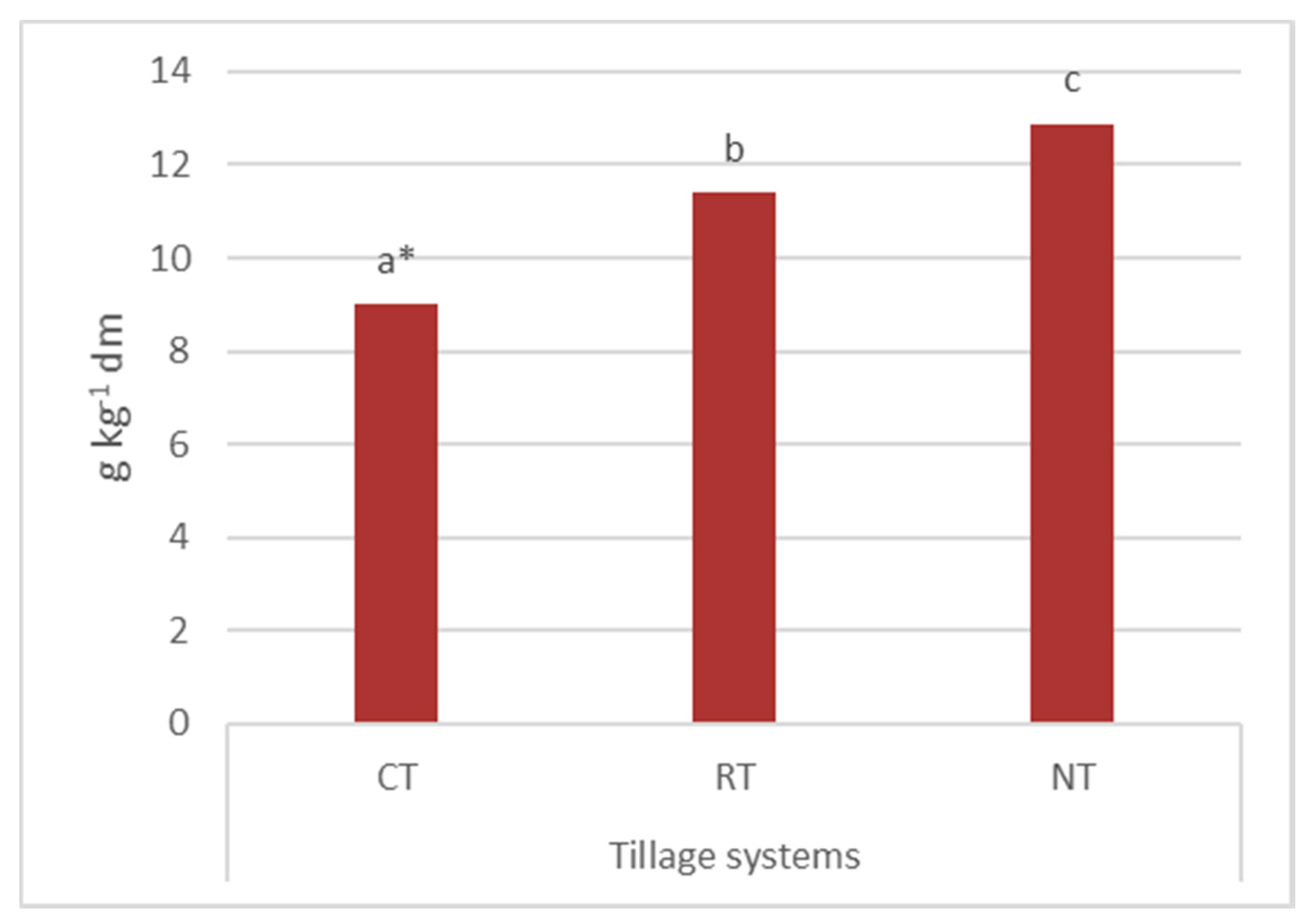
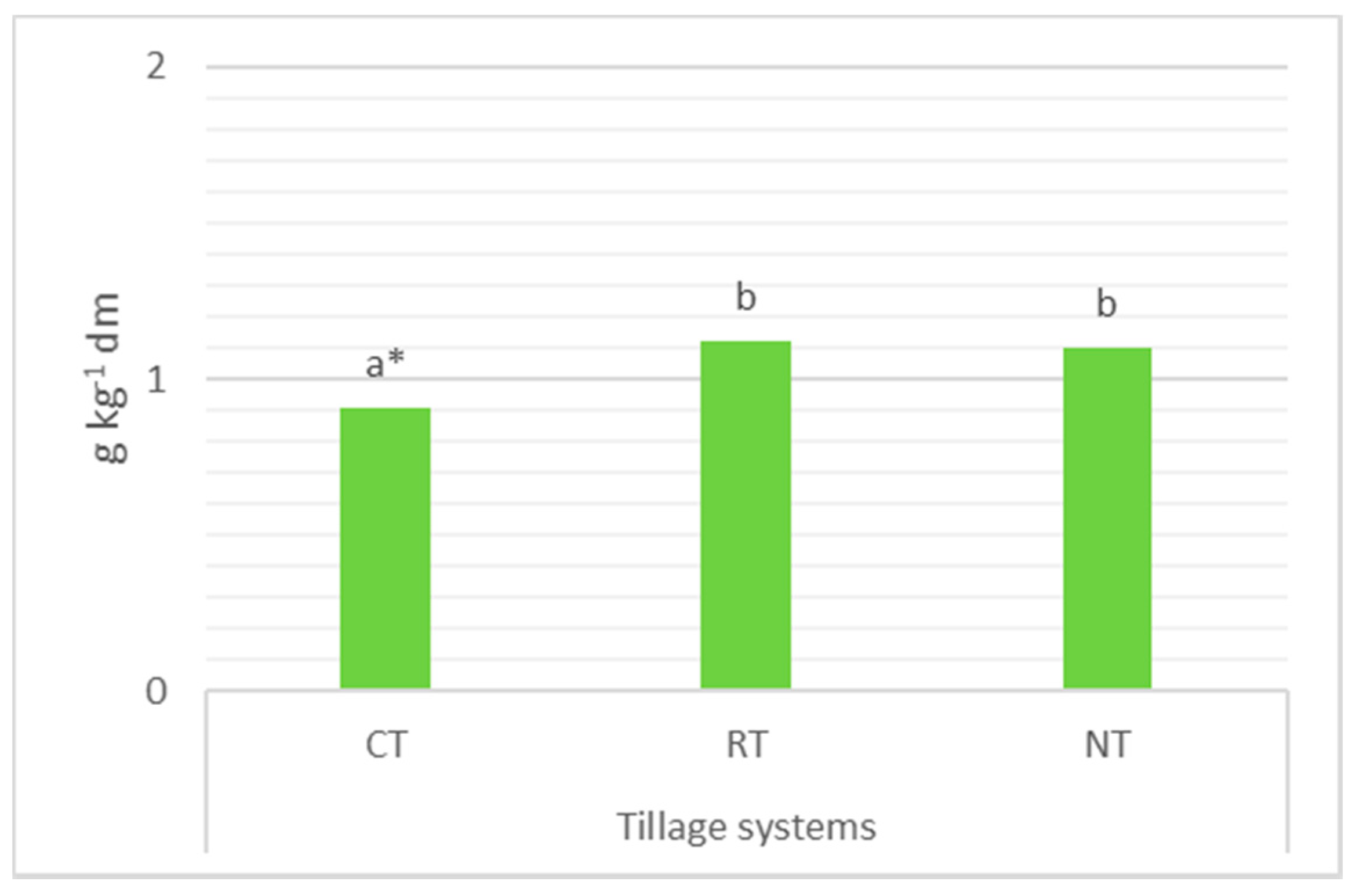
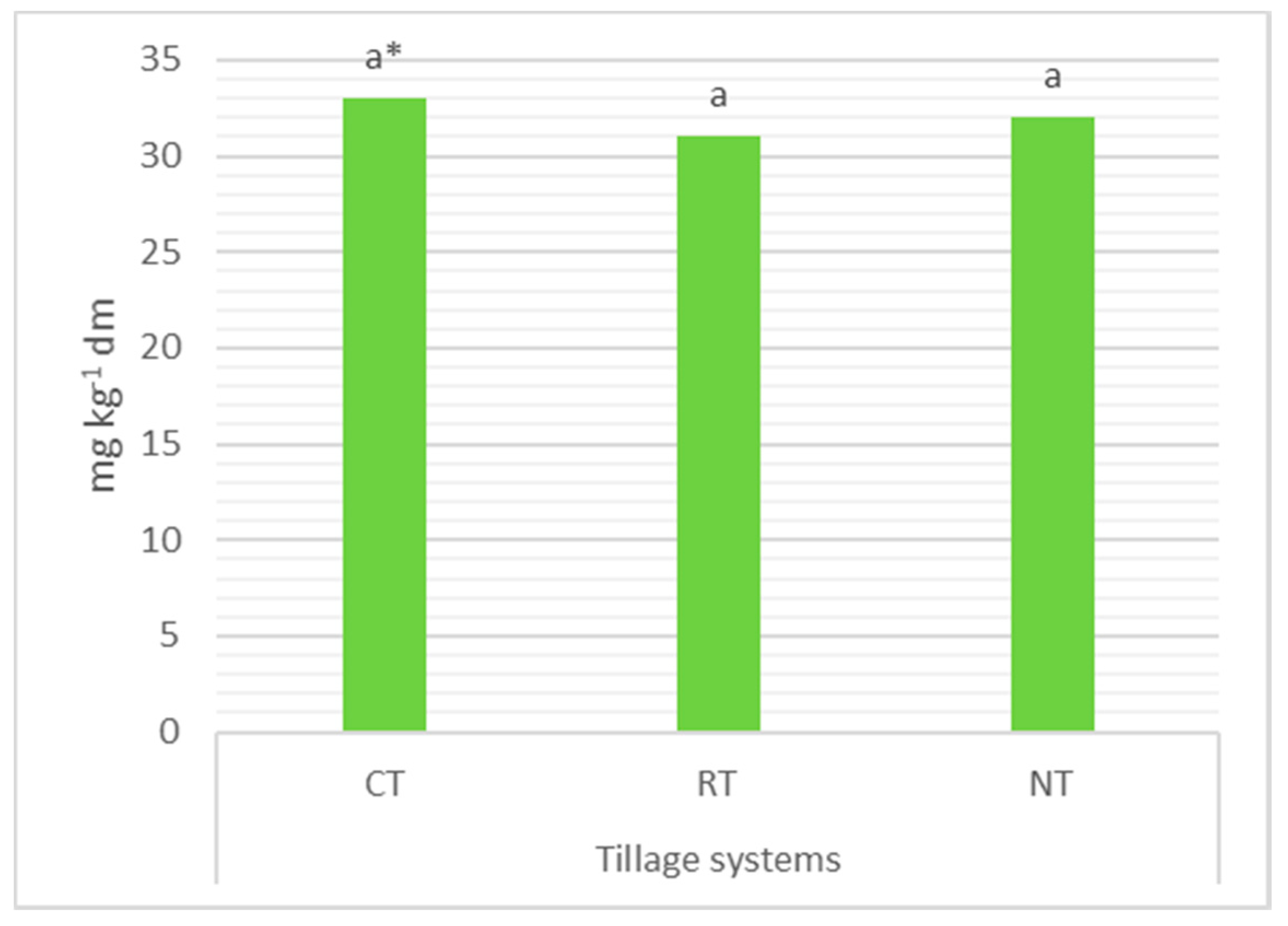
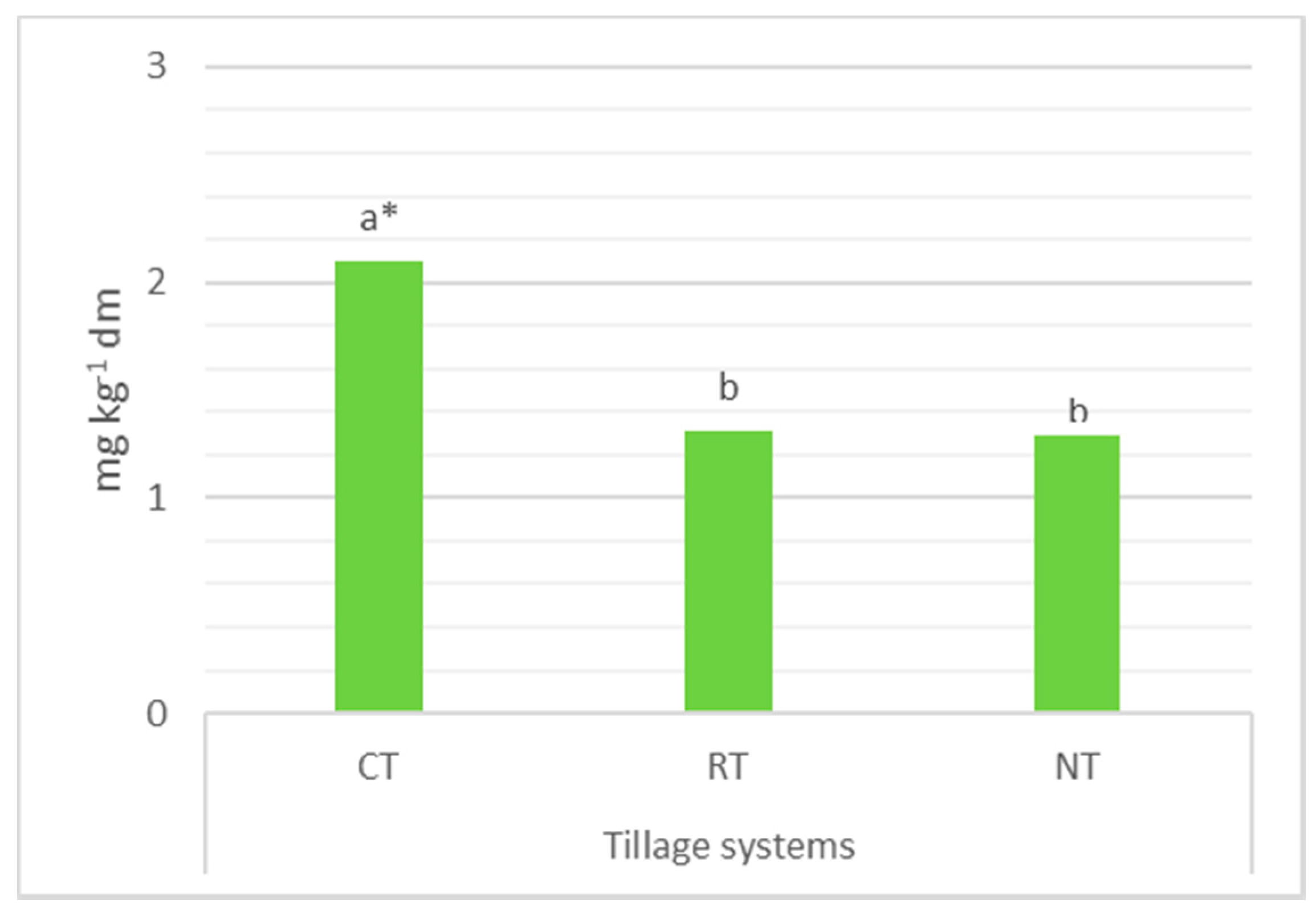
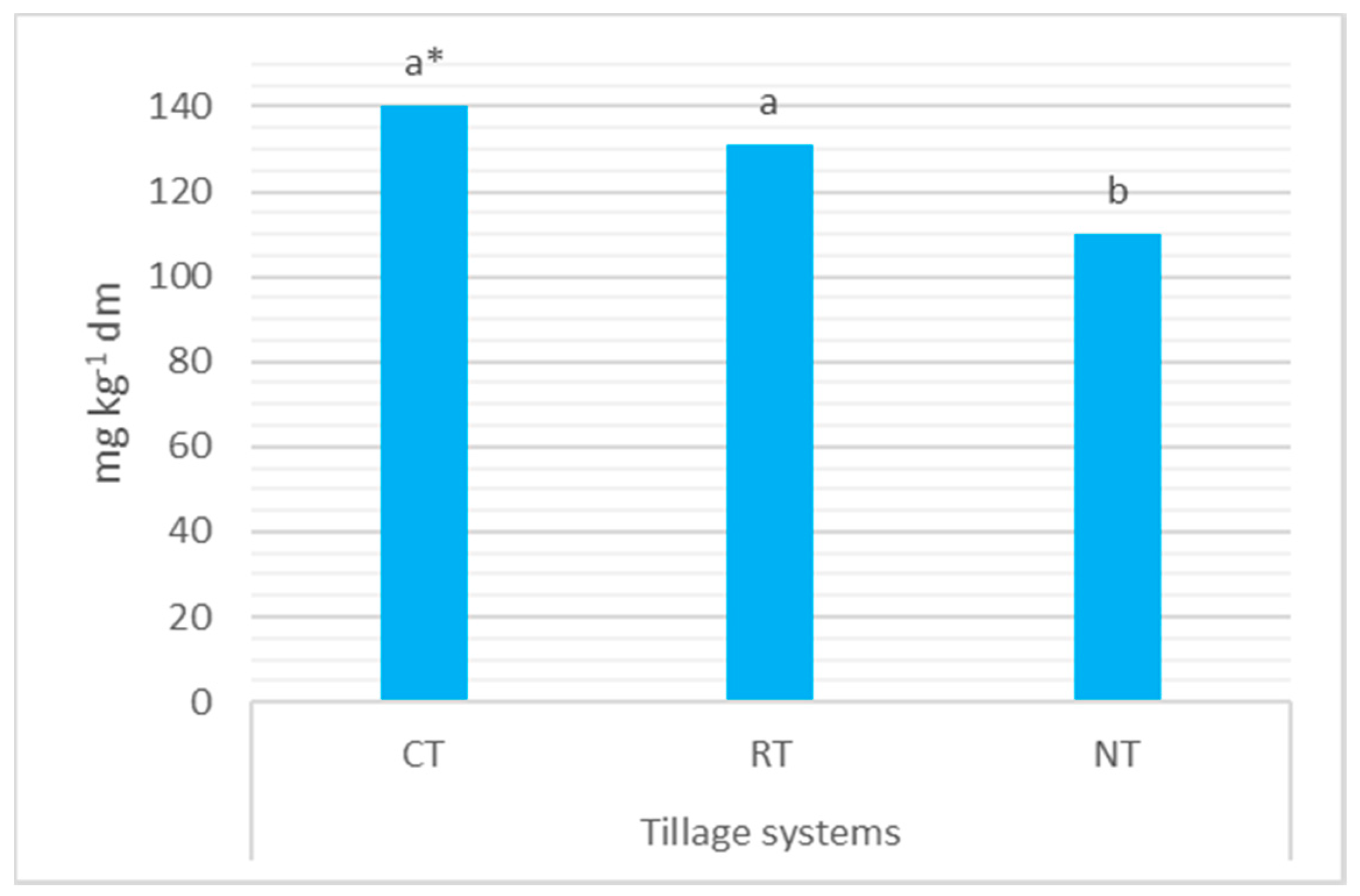
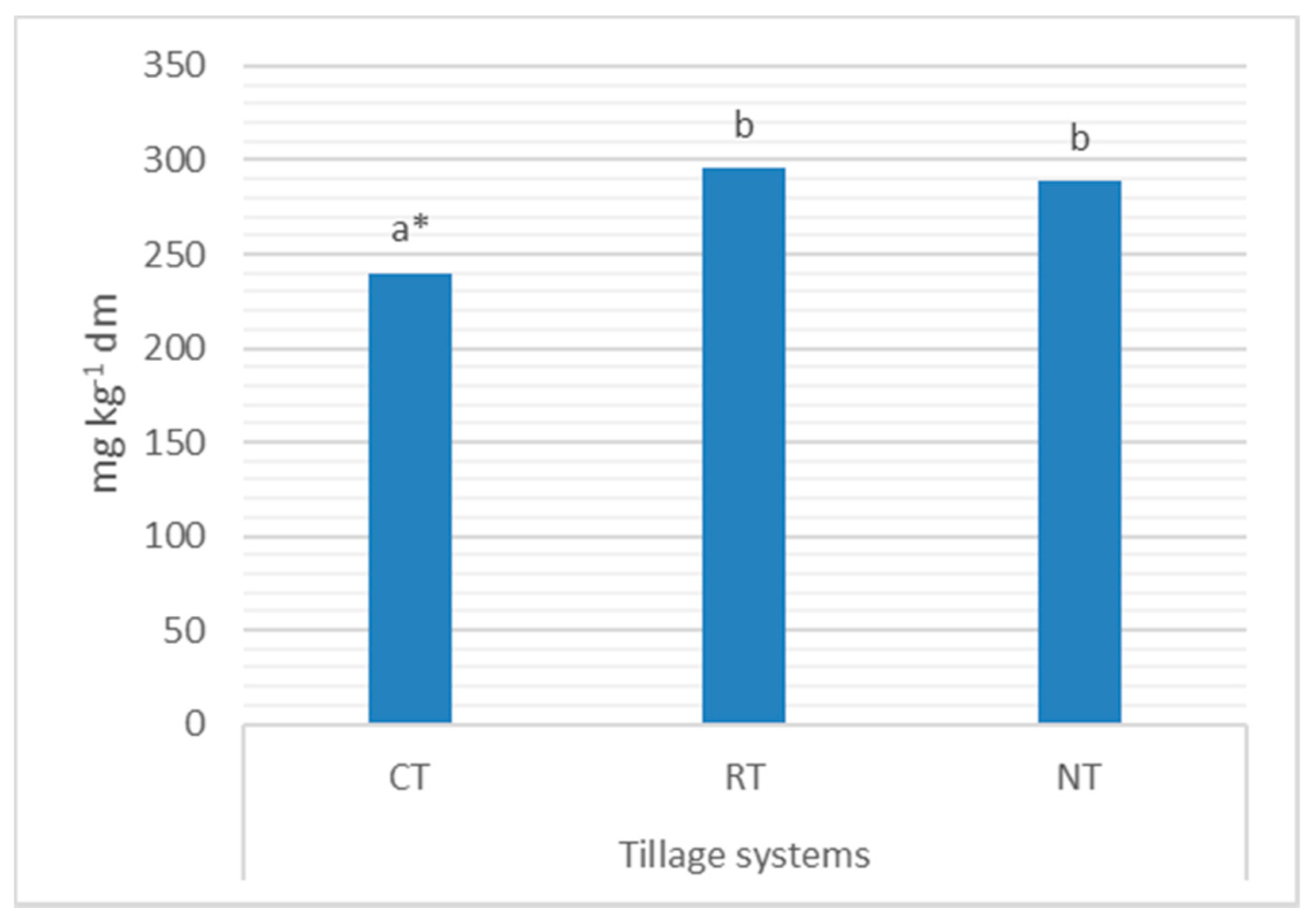
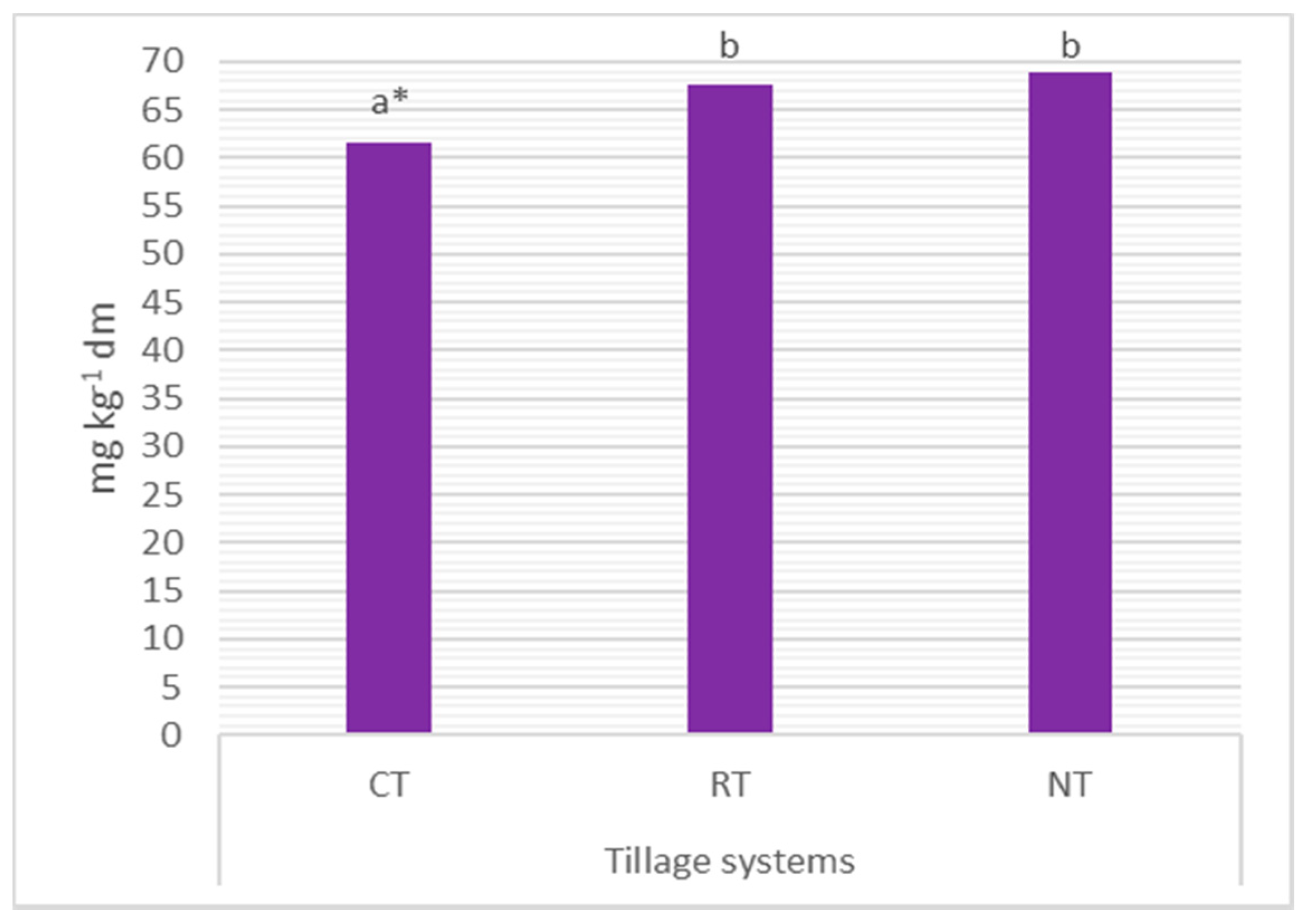
| Specification | Grain Yield (t ha−1) | Spike Number (m−2) | Grain Weight per Spike (g) | 1000 Grain Weight (g) |
|---|---|---|---|---|
| Tillage System (TS) | ||||
| CT | 5.31 a | 456.5 a | 1.15 a | 45.0 a |
| RT | 5.21 a,b | 448.1 a,b | 1.16 a | 42.4 a |
| NT | 5.08 b | 419.7 b | 1.19 a | 43.2 a |
| Mean | 5.20 | 441.4 | 1.17 | 43.5 |
| Year (Y) | ||||
| 2014 | 5.48 a | 483.3 a | 1.13 a | 48.5 a |
| 2015 | 4.39 b | 397.6 b | 1.10 a | 39.2 b |
| 2016 | 5.73 c | 443.4 c | 1.28 b | 42.9 b |
| Mean | 5.20 | 441.4 | 1.17 | 43.5 |
| ANOVA | ||||
| TS | * | * | ||
| Y | * | * | ** | * |
| TS × Y | * | * |
| Specification | Grain Weight per Volume (kg hL−1) | Grain Uniformity (%) | Total Protein (g kg−1 dm) | Wet Gluten (%) | Zeleny’s Sedimentation Index (mL) | Total Ash Content (g kg−1 dm) |
|---|---|---|---|---|---|---|
| Tillage System (TS) | ||||||
| CT | 76.5 a | 86.8 a | 116.3 a | 21.8 | 34.4 a | 20.2 a |
| RT | 74.6 a | 84.3 a,b | 115.6 a | 21.9 | 34.1 a | 20.7 a |
| NT | 75.4 a | 79.3 b | 118.3 a | 22.8 | 36.4 a | 22.1 b |
| Mean | 75.5 | 83.5 | 116.7 | 22.2 | 35.0 | 21.0 |
| Year (Y) | ||||||
| 2014 | 76.5 a | 86.1 a | 117.0 a | 21.6 | 33.1 a | 17.2 a |
| 2015 | 70.9 b | 72.1 b | 121.0 a | 21.8 | 32.1 a | 28.4 b |
| 2016 | 79.1 a | 92.5 c | 112.3 b | 23.2 | 39.8 b | 17.4 a |
| Mean | 75.5 | 83.5 | 116.7 | 22.2 | 35.0 | 21.0 |
| ANOVA | ||||||
| TS | * | * | ||||
| Y | ** | ** | ** | * | * | ** |
| TS × Y | * |
© 2020 by the authors. Licensee MDPI, Basel, Switzerland. This article is an open access article distributed under the terms and conditions of the Creative Commons Attribution (CC BY) license (http://creativecommons.org/licenses/by/4.0/).
Share and Cite
Woźniak, A.; Rachoń, L. Effect of Tillage Systems on the Yield and Quality of Winter Wheat Grain and Soil Properties. Agriculture 2020, 10, 405. https://doi.org/10.3390/agriculture10090405
Woźniak A, Rachoń L. Effect of Tillage Systems on the Yield and Quality of Winter Wheat Grain and Soil Properties. Agriculture. 2020; 10(9):405. https://doi.org/10.3390/agriculture10090405
Chicago/Turabian StyleWoźniak, Andrzej, and Leszek Rachoń. 2020. "Effect of Tillage Systems on the Yield and Quality of Winter Wheat Grain and Soil Properties" Agriculture 10, no. 9: 405. https://doi.org/10.3390/agriculture10090405





